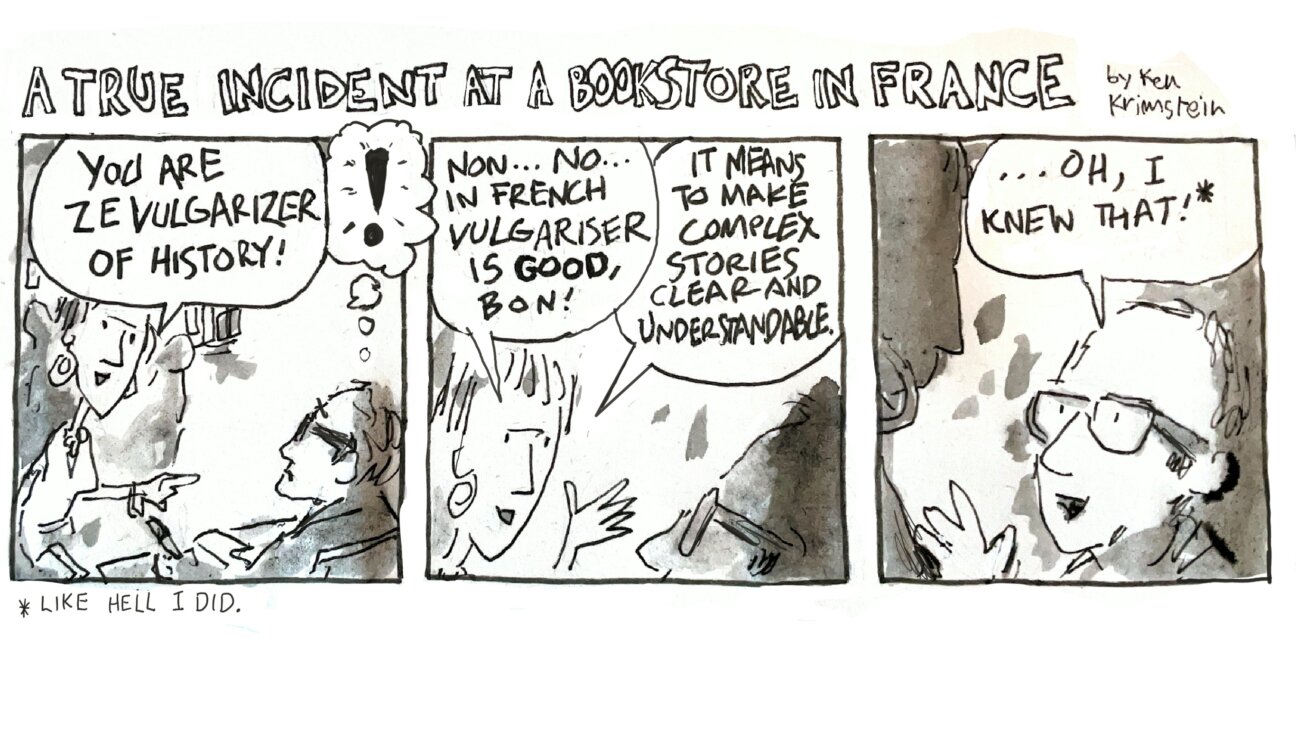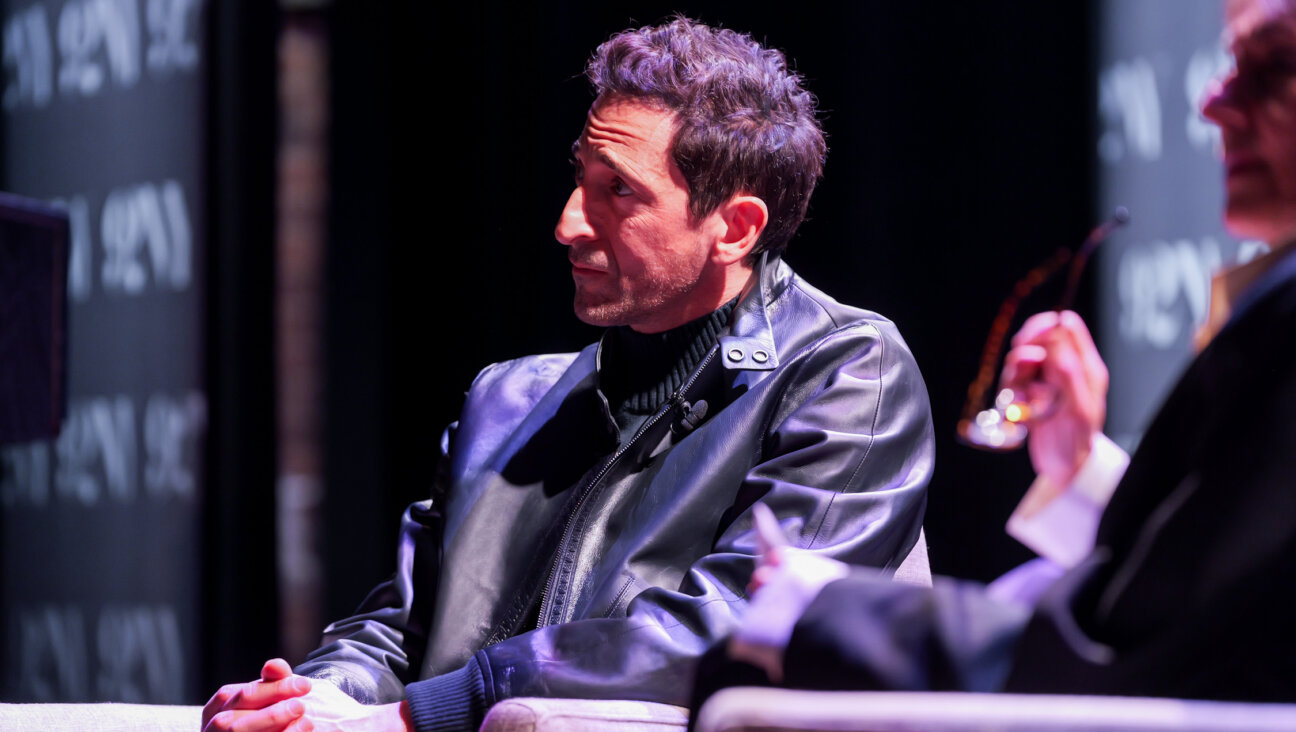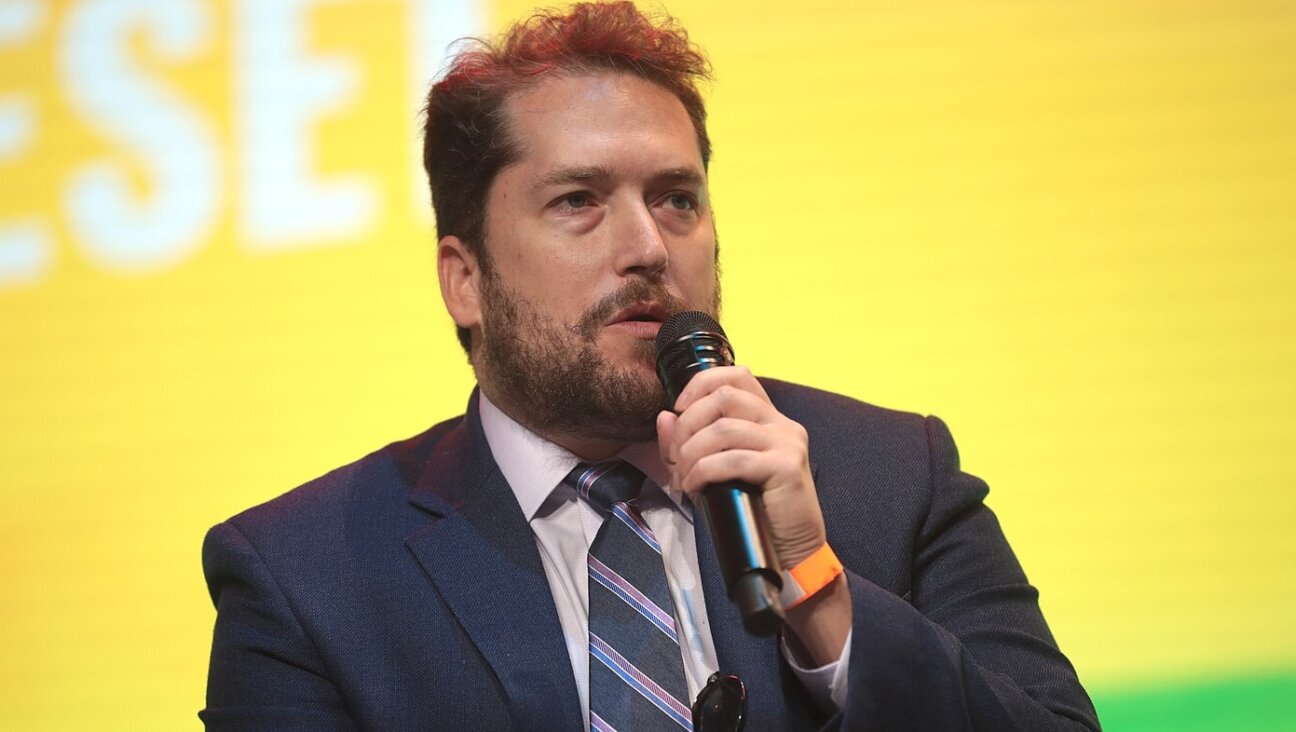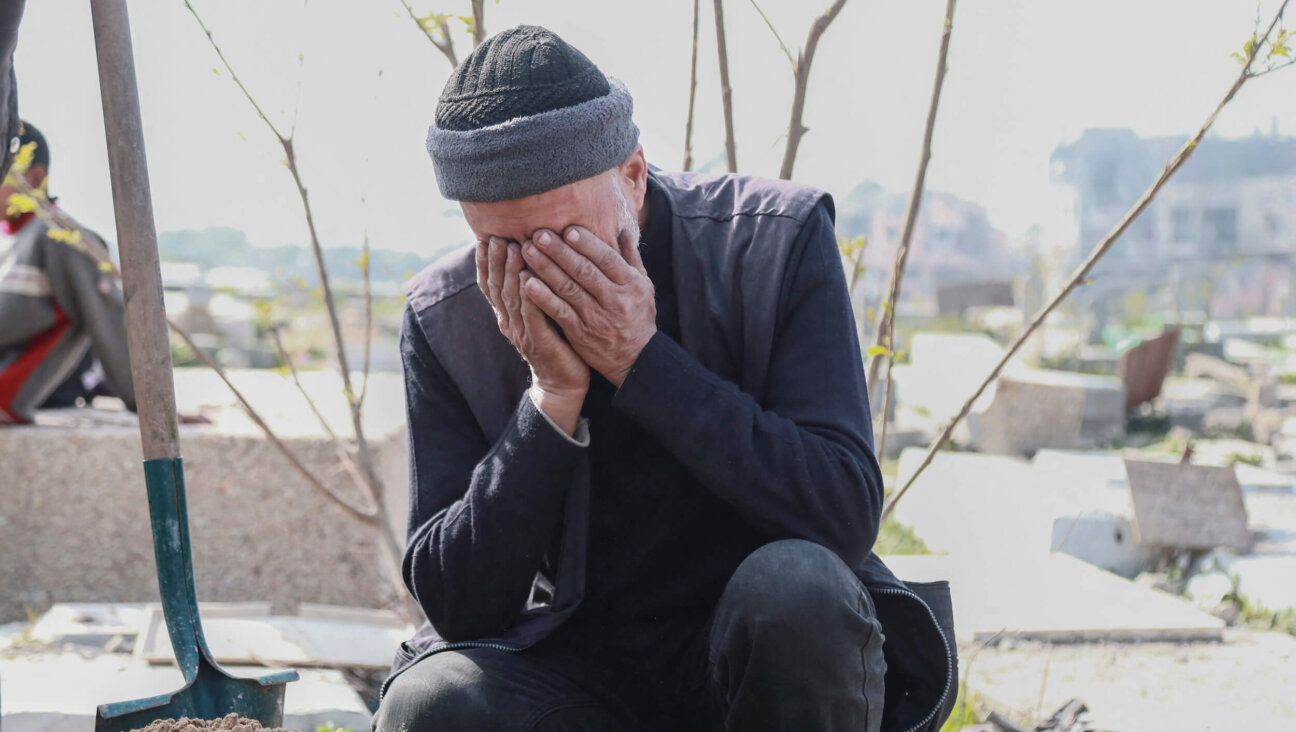A ‘Child of Daumier’ Confronts the 1990s
Jack Levine died at his home on Monday, November 8, aged 95. An American Social Realist painter who disliked the expressionism and abstract painting he saw become popular during his lifetime, Levine depicted, with visceral force, the social interactions between people. Often these skewered the powerful, as described in this 1997 profile and studio visit written by then arts editor of the Forward (and current executive editor of ARTnews), Robin Cembalest.
Originally published in the Forward August 22, 1997.
A ‘Child of Daumier’ Confronts the 1990s
Jack Levine Talks About Judaism, Abstraction and Newt Gingrich
For several years now, Jack Levine has been fussing with a painting he calls “Finger of Newt.” Inspired by the Macbethian pun, it shows the House speaker in a Capitol Hill setting, with a bust of Jefferson in the background and Bob Dole and Timothy McVeigh at his side. Mr. Levine has got the faces down, but the rendering of Mr. Gingrich’s hand — which he plans to depict in a rude gesture — is giving him all kinds of trouble. “I went to pieces trying to paint the finger,” he laments. “He’ll be out in two years and I won’t be done.”
The image is irreverent, to say the least, but its audacity is typical of Mr. Levine, an acerbic critic of politicians, the art world and just about every other establishment order who is still going strong at 82. Best known for the raucous images of self-satisfied generals, corpulent mobsters, pompous senators and other malevolent types that made him a young art star in the ‘30s, he is now focusing his contempt on more contemporary manifestations of society’s ills. “I want to do a painting of the fashion business,” he comments. “I hate the fashion business.”
While Mr. Levine’s themes may resemble those of the social realists who were his contemporaries, his style owes more to German Expressionists like George Grosz; his caricature to an earlier age when artists functioned as society’s gadflies. “He is one of the finest practitioners of not simply social realism but a very trenchant vein of visual satire,” notes Judith Zilczer, a curator at the Hirshhorn Museum and Sculpture Garden in Washington, D.C., which owns 14 paintings and 11 prints by Mr. Levine. “He is interested in the larger human comedy. You could see him in the tradition of Hogarth and Rowlands.”
“I’m not a child of Cezanne,” Mr. Levine contends. “I’m a child of Daumier. I have a right to be. It’s a free country.”
A show of Mr. Levine’s work at the George Krevsky Gallery in San Francisco (from August 28 to September 27) provides a small survey of his production over the last six decades. It includes an etching of his “Feast of Pure Reason,” a 1937 painting in New York’s Museum of Modern Art whose title comes from Joyce’s Stephen Daedalus and whose subject is the Tammanyesque ambience of City Hall in his native Boston. There is “Auction,” a 1987 study of grotesque hoi polloi in a saleroom. There are paintings of Jewish subjects, among them Moses on Sinai, Maimonides and Judas Maccabeus, along with an ink study of the Warsaw Ghetto. And there is a portrait of El Greco, one of the Old Masters who are Mr. Levine’s prime inspirations.
“He’s an extraordinary draftsman,” says David Levine, an artist and illustrator for the New York Review of Books who has known Jack for many years. “If I could think of a painter who had as many ways of using paint I’d go back to Titian.”
An erudite, sardonic man with gruff charm, Mr. Levine works in a skylit studio in a 19th-century Greenwich Village house scattered with tomes that traverse Western art history — stopping short about 1920. He disdains the avant-garde, holding his highest scorn for abstraction and other non-figurative art. “I never was a card-carrying modernist,” he says. “All of my paintings — except for a couple of landscapes, and a flower painting I painted for spite — are portraits of people interacting.”
The youngest of eight children of Lithuanian-born parents, Mr. Levine grew up in the South End of Boston, a pushcart-filled neighborhood of immigrants. He started drawing at a young age, storing his pencils in the coal stove during the summer, when his mother cooked on the gas range; in the winter, when the perishables sat on the window ledge, he put his supplies in the icebox. In classes at the Boston Museum, and later with individual instructors, he learned to copy from Greek casts, replicate Renaissance perspective and other technical skills.
When he was in his early 20s, Mr. Levine hooked up with the Works Progress Administration and artists who were finding inspiration in poverty, labor and other social issues. But even as he, too, turned his eye to life on skid row, he never adapted the heroic style favored by most of his colleagues. For one thing, his work was hardly realistic: his figures often appeared as though they had been distorted in a fun-house mirror. For another, his aims were less grand. Many of artists of the ‘30s, he has said, “had some sort of naïve hope…that their painting was leading toward a revolution that would solve everything….I knew damn well that paintings of mine, if they got to museums, wouldn’t have any social effect.”
His association with the WPA, however, did have a positive effect on his career. The organization circulated his works to its own galleries as well as museums like MoMA — which leased “Feast of Pure Reason” for 100 years and bought several other works. The Metropolitan Museum, the Whitney and a host of other institutions soon followed suit.
In 1939, Mr. Levine’s father died, and though he had quit Hebrew school before his bar mitzvah, he was the only one of his siblings to recite “Kaddish” faithfully throughout the mourning period. The experience inspired him to paint a series of kings and teachers of Israel — “King David Playing the Harp,” “King Josiah,” “Planning Solomon’s Temple” — influenced by Flemish masters like Van Eyck and Van der Weyden. “A lot of my co-ethnics, Jewish people that is, thought that I did this Judaica because I’m a good Jew and might be pious,” he told an interviewer. “When the fact of the matter is that it gave me access to material that I had a legitimate right to.”
After a stint in the army during World War II, Mr. Levine moved to new York, where he met and married his wife, Ruth Gikow, a Ukrainian-born artist whose works are also on view in the Krevsky show. Like her husband, Gikow, who died in 1982, began her career in the WPA and found her inspiration in the streets: from Gypsies on the Lower East Side to the “be-ins” of the ‘60s. While there is a touch of melancholy to many of her works, like the “Blind Musician” of 1952 in the Whitney, they are more humanistic, lacking her husband’s bitter edge. Following more in the tradition of her teacher Raphael Soyer, she also drew widely from Old Masters, Pompeiian wall paintings and Byzantine mosaics the couple saw on their travels through Europe.
When they returned to New York in 1951, the art scene had changed — Abstract Expressionism was in, figuration was out. It made no difference to Mr. Levine. “I come of people who do not even acknowledge Jesus Christ,” he has said. “Why am I supposed to acknowledge Abstract Expressionism?”
Instead he continued his social critiques, painting prisoners in Spanish jails, protesters in Birmingham, arms brokers and, after repeated visits to Israel, new series of sages and biblical scenes. “I couldn’t lie down and die when this kind of avant-garde thing hit,” he says. “I had to make a life for myself.”
His antipathy toward the art world has only increased over time; despite the fact that most of the country’s modern-art museums own his paintings, he notes, “my works are in the basement.” Indeed, his work is not currently on view at MoMA, the Met or the Hirshhorn, a reflection, perhaps, of the decline in status of his brand of figurative social commentary in an era when most political art comes in the form of multi-media installations. His “Gangster Funeral” of 1952-53, though, is on display at the Whitney —as part of a temporary show of objects from the permanent collection selected, ironically enough, by visiting curators from London’s Tate Gallery.
These days, Mr. Levine doesn’t read the papers, although he buys the New York Post for its crossword puzzle and subscribes to Biblical Archeology Review. He gets his news from television, and is fond of British situation comedies. “That’s as escapist as you get,” he says. He sees a lot of his daughter, Susanna Levine-Fisher, who lives nearby with her husband and twins (and is also a painter, whose work was shown with that of her parents at the B’nai B’rith Klutznik Museum in Washington D.C. in 1995).
Along with his Gingrich painting, Mr. Levine has a number of ongoing projects. He is making a print to accompany a musical composition by the late Hugo Weisgall and a poem by Cynthia Ozick to commemorate next year’s centennial of the American Academy of Arts and Letters, of which he was president from 1990 to ’93. He is finishing up a painting of Moses on Sinai. And he is still toying with a lion he has been working on for some 35 years. “It’s not the lion of Judah,” he notes. “I could fake it and write lion in Hebrew. But I don’t feel like doing that.”
If he’s faded a bit from public consciousness, Mr. Levine certainly has no regrets about the course he chose — and stayed on for the duration of his career. “Modernism has no ethnic,” he states. “I finally reduced it to that.”
A message from our Publisher & CEO Rachel Fishman Feddersen

I hope you appreciated this article. Before you go, I’d like to ask you to please support the Forward’s award-winning, nonprofit journalism so that we can be prepared for whatever news 2025 brings.
At a time when other newsrooms are closing or cutting back, the Forward has removed its paywall and invested additional resources to report on the ground from Israel and around the U.S. on the impact of the war, rising antisemitism and polarized discourse.
Readers like you make it all possible. Support our work by becoming a Forward Member and connect with our journalism and your community.
— Rachel Fishman Feddersen, Publisher and CEO























